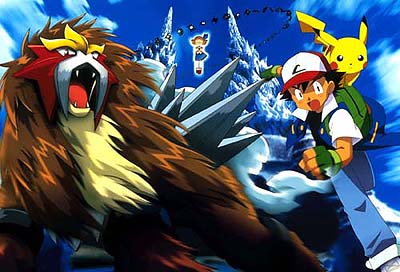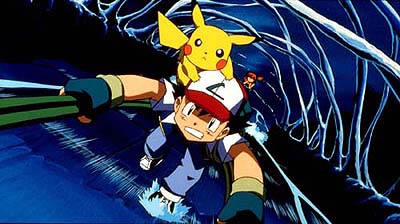

The Pokemon craze is probably coming to a close. The media attention surrounding these cute characters is mostly gone, except for occasional stories, like the recent banning of them by Saudi Arabia. Pokemon exists now primarily on the WB Network and Nintendo game consoles. Pokemon 3 attempts to milk this fad while it is still alive by artificially creating new demand for its products. Although this can pretty much be said of many children's movies, Pokemon 3 (subtitled The Spell of the Unown) hearkens back to the 1980s when some claimed that the primary purpose of cartoons was to push toys, and in this case cards. If done well, it is easy to forgive these ninety-minute commercials, but Pokemon 3 does not approach this level. This is the third movie (so far) in the franchise, yet there is no real difference in quality (storywise or otherwise) from its predecessors or the television show.
Pokemon 3 begins with a 20 minute short entitled Pikachu and Pichu, which is where the commercialization comes in. Aside from a hearty warning for kids to avoid hallucinogenics (hey kids, do drugs and you'll see things like this!). Pikachu wanders around a city with the Pichu brothers, having strange adventure with stranger creatures. Again, Ash and friends encounter all-new Pokemon, which undoubtedly will make their ways to trading card infamy. This time, the Pokemon are Entei, a lion-like creature, and the Unown, small, letter-like eyes. A scientist researching these Pokemon goes missing, leaving his young daughter Molly alone. The Unown seemingly have the power to grant wishes, so Molly unwittingly creates a crystalline fantasy world with a fake parents. It's up to Ash (voiced by Ash regular Veronica Taylor) and his friends and Pokemon to save the day and turn things back to normal. The story does not even last the entire movie. Pokemon 3 needs two separate movies to keep the attention of kids, although it was written by Takeshi Shudo and Hideki Sonoda, adapted for American audiences by Michael Haigney and Norman Grossfeld, and directed by Kunihiko Yuyama (Japan) and Haigney (US). One wonders what was lost in the translation. As with the other Pokemon movies and cartoons, the translation is not direct. Haigney and Grossfeld (who worked on the other movies and the television show) translate some of the movie and then add much for the American audiences.
Like Pokemon and Pokemon 2000, Pokemon 3 is not a horrible movie (although this hardly constitutes an endorsement). It just doesn't do anything to make it a good one. The screen is bigger, and the story is theoretically more epic, but it never rises above the quality of the television show. This is not a movie so insipid kids that parents will cringe while watching it. The movie blasts the screen with continuous sensory overload and a small message stressing the virtues of teamwork and family at the end in order to give it some redeeming qualities. As a showcase for Entei and the Unown, Pokemon 3 does nothing. They pop up, then disappear, and still remain mysterious. Even worse, one of the more emotional plots of the story (which was never adequately laid out) plays out over the end credits, and resolve itself with no explanation, and no dialogue. The animation is the same as the cartoon, with some CGI graphics added that look vastly different from everything else on screen. By not stretching the creativity of this franchise, Pokemon 3 does nothing to trigger a resurgence in interest, leaving its long-term viability shaky, at least until the next movie (it looks like there was a fourth in Japan) or until a new fad eclipses this one.